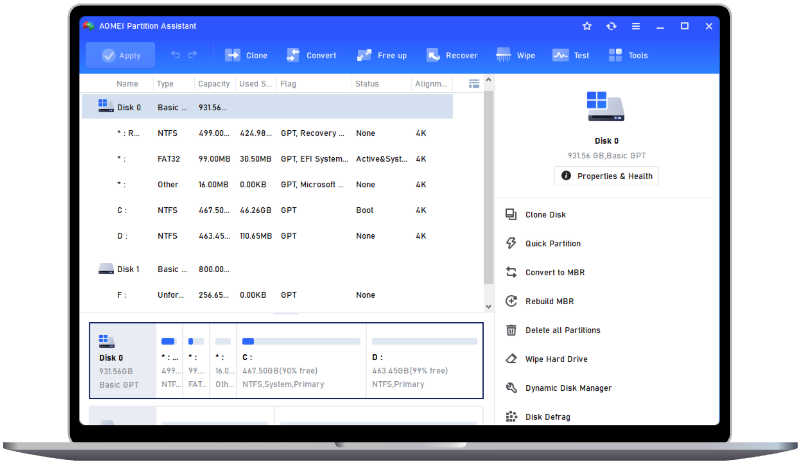How to Add Unallocated Drive Space on the OS Drive?
This article will show you how to add unallocated drive space on the OS drive, helping you optimize disk management and improve system performance.
Why should we add unallocated drive space to the OS drive?
Unallocated disk space refers to the portion of your drive that is not assigned to any partition. This space cannot be used to store programs or data, essentially remaining inaccessible.
The OS drive, commonly identified as the C: drive, usually refers to a partition that contains the computer’s operating system. It holds many critical system files, software, and configuration settings.
Over time, numerous files accumulate on your OS partition, leading to the "Low Disk Space" issue. This can severely impact your system's performance, causing it to slow down or even crash. Don't worry—there’s a solution! Adding unallocated space to your OS drive can help you resolve this painful issue.
This article will show you how to add unallocated drive space on the OS drive. By following the steps below, you can effortlessly optimize disk management and improve system performance.
How to add unallocated drive space on the OS drive?
Can unallocated space be put in the OS drive? Sure! This section provides two practical methods for incorporating unallocated drive space into your OS drive. Keep reading to select the one that works best for you.
Solution 1. Add Unallocated Drive Space to the OS Drive via Disk Management
Windows provides the Disk Management tool, which allows you to organize and manage drives. If unallocated space is located behind the OS drive, it can be directly merged into the OS drive. Here’s how to move unallocated space right next to the OS partition via Disk Management:
Step 1: Right-click on the Start menu and select Disk Management. Check if there is unallocated space immediately following your OS drive. If so, follow these steps below to extend your OS drive with unallocated space.
Step 2: Right-click on the OS (C:) drive and select the Extend Volume option.
Step 3: In the pop-up window, click Next to continue.
Step 4: In the following window, select the disk where you intend to free up space and set the amount of free space in MB. Then click Next.
Step 5: You can review the summary of actions, and click Finish to commit it.
Step 6: In just a few moments, the OS drive will be successfully extended with unallocated space.
Solution 2. Add Unallocated Drive Space on the OS Drive Using Third-Party Software
What if the unallocated space is not adjacent to the OS drive? Don’t worry! There is a powerful tool - AOMEI Partition Assistant that allows you to safely add unallocated space into any partition regardless of whether it is right behind the target partition or not. With this tool, you can effortlessly resize partitions on Windows 11, 10, 8/8.1, and 7, including extending, shrinking, merging, and splitting partitions.
Here’s how to extend partitions with unallocated disk space using AOMEI Partition Assistant:
Step 1. Launch AOMEI Partition Assistant, right-click the partition (here is C:) you want to extend, and click Advanced > Merge Partitions.
Step 2. In the pop-up window, tick the unallocated space and C: drive boxes, then click OK to continue.
Alternatively, you can first move the partition between the aim partition and unallocated space to the right side, then extend the partition with adjacent unallocated space.
Step 3. You can preview the operation by viewing the Pending Operations. If everything looks correct, click Apply and Proceed to execute the operation.
Step 4. Wait for the process to be finished. Once complete, your OS drive will be extended to include the unallocated space.
Pro Tip: Allocate Free Space to OS Drive
Sometimes, you may encounter a situation where no unallocated space is available to extend your OS drive. In such a case, consider reallocating space from another partition to extend the OS partition. Simply use the Allocate Free Space feature, which allows you to transfer free space directly from the source partition to the target partition.
Step 1. Launch the software, right-click the partition that you want to allocate free space from (here is D:), and select Allocate Free Space.
Step 2. Enter the amount of free space you want to transfer from the D: partition to the C: drive, then click OK to proceed.
Step 3. You can preview the operation by viewing the Pending Operations. Then click Apply and Proceed.
Step 4. Wait for the process to complete. Once finished, your OS drive will be successfully extended.
To Sum Up
Over time, your OS drive may run out of space because of the accumulation of files. Adding unallocated drive space on the OS drive can effectively address this painful issue. In this article, we have explored two solutions. AOMEI Partition Assistant stands out for its convenience and flexibility, allowing you to add both adjacent and non-adjacent unallocated space to the OS drive.
Apart from resizing partitions flexibly, this software is also able to clone partitions, clone hard disks, migrate OS drive to SSD/HDD, and more. If you require partition management in Windows Server, consider trying the Server edition (2012, 2016, 2019, 2022, and 2025).
FAQs
Q1: Why is there unallocated space on my hard drive?
Unallocated space is commonly created as unused space by default, either by the manufacturer or during initial setup. Additionally, you can also get unallocated space by deleting or shrinking a partition.
Q2: Why is the Disk Management option greyed out on unallocated space?
It typically means you cannot interact with the space using the usual options. This can happen for a few reasons, including disk errors, specific disk types (like dynamic disks), or lacking permission.
Q3: Will adding unallocated space to a partition erase my data?
In most cases, adding unallocated disk space to the OS drive will not erase your data. However, it's always a good idea to back up your data before making any changes to your disk partitions.


